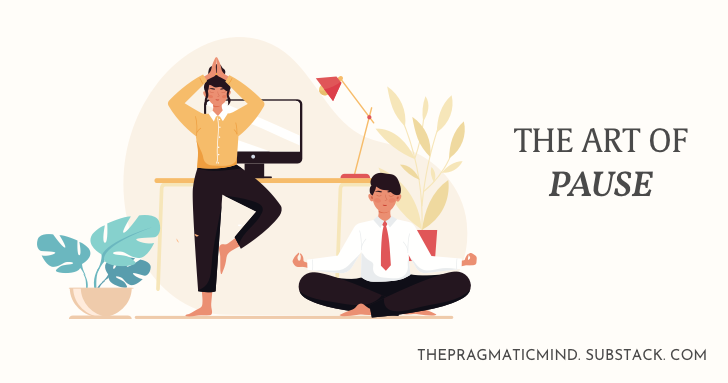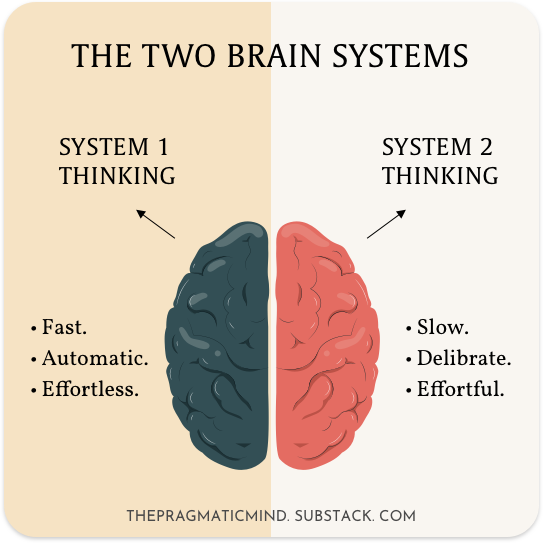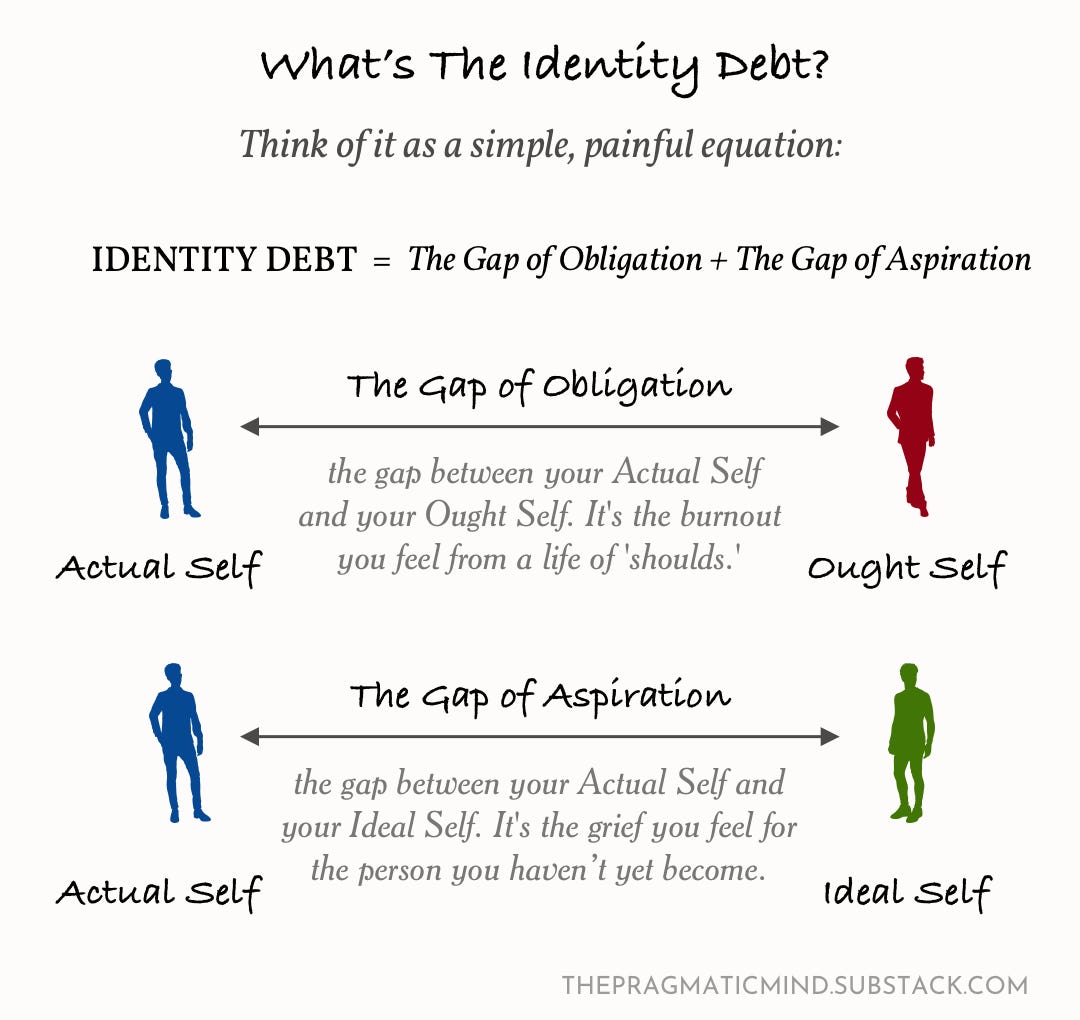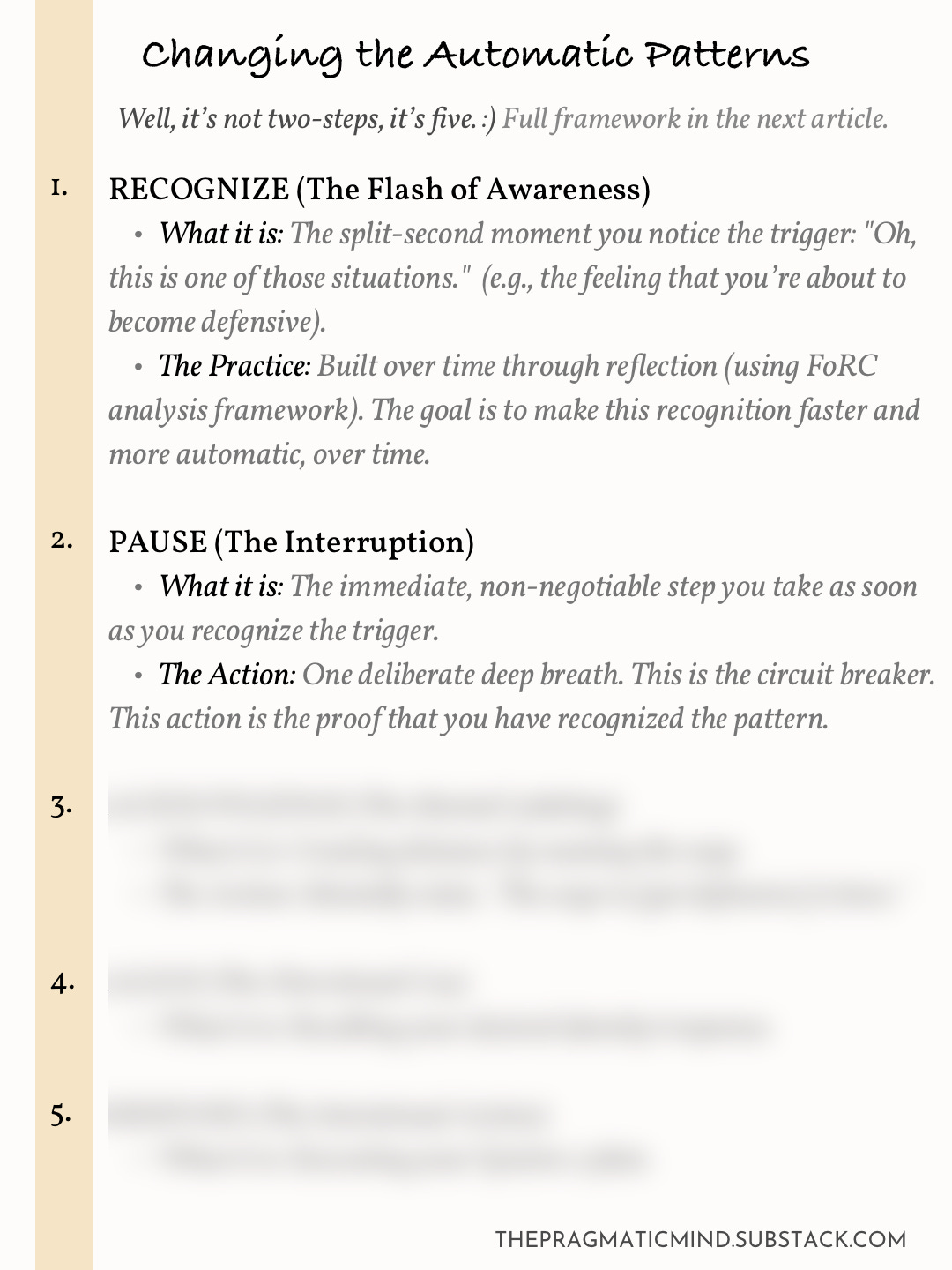Moving forward, I'll be adding a summary (TL;DR, too long, didn’t read) of the article at the very top for readers who are Identity-rich but low on time. :)
TL;DR
Our unconscious patterns often act before we’re even aware of them.
The key to interrupting these fast, automatic behaviors is learning to Pause. It's one conscious breath that breaks the circuit.
The Pause creates a space where choice can exist.
You can train for engaging the Pause using physical, environmental, digital, and mental totems.
Mastering the Pause is how you shift from reaction to intention, and begin reversing your Identity Debt.
Now, let’s dive in.
The Speed of the Behavioral Pattern
There was a moment of realization... but only after the damage. The words were already leaving my mouth before I even realized I was speaking.
"That's not how we usually do things around here," I said.
The dismissive tone, the subtle condescension, the automatic defensiveness... it all happened in the span of a heartbeat. My younger colleague had suggested a new approach. But, somewhere in the milliseconds between her words reaching my ears and my response escaping my lips, my automatic behavior had already taken over control.
I watched as the expressions on her face changed. The enthusiasm in her eyes slowly drained out. And the creative spark I'd just extinguished with my reflexive territorialism hung in the air between us, like smoke.
When I look back at that moment, I have to admit, it wasn't one of my better ones. And now, years later, I understand the psychological part behind it.
That moment illustrates the terrifying speed at which our unconscious patterns emerge. They arrive unannounced. And they don't wait around for our permission. Human evolution intended them to operate this way, all while our conscious, deliberate selves are still trying to catch up to them.
The unconscious pattern is always quicker than the conscious choice.
Your thumb is already scrolling before you even register the anxiety that triggered the act of reaching for your phone. Your shoulders are already tensing before you even realize you're bracing for criticism. Your mouth is already saying "yes" before your mind has even calculated whether you actually want like to agree to it or not.
These patterns exist in the realm of System 1 — the fast, automatic, instinctive mode of our thinking. System 1 has optimized the patterns via thousands of repetitions to operate below the threshold of consciousness. Those same patterns become faster than thought, and quicker than intention.
Our behavioral patterns are neurological reflexes that have learned to outrun our awareness. They've become so efficient, so effortless, that they execute before our conscious minds can even show up to the party.
By the time we realize what's happening, the damage is already done, the words have already been spoken, those old familiar choices... have already been made. And you keep sinking further and further into an already compounding Identity Debt.
But what if there was a way to slow the game down? Just enough to create the space for a different choice to emerge.
The Circuit Breaker
All conscious change begins with a flash of awareness.
That ‘flash of awareness’ lives in that often jarring moment when you catch yourself mid-pattern. It's that split-second recognition when you realize you're about to repeat the same old sequence of behavior.
This recognition creates a window. But that window doesn't last too long. It lives just long enough for a couple of heartbeats. And in this crucial, fleeting moment between recognition and automatic action, lies the space to activate the circuit breaker... the Pause.
The Pause is the simple yet profound act of taking one deliberate, conscious breath the moment you recognize a pattern is beginning to activate. One breath. One conscious interruption of the unconscious flow. One tiny declaration that you are consciously present in that very moment.
When your mind's neural network is about to surge — when that familiar pattern is charging toward its predictable conclusion — the Pause, that one conscious breath, breaks that circuit. It cuts the power. It creates a gap where making a conscious choice becomes possible.
The Journey From Pause to Intentional Choice
The Neurological Interruption
Every automatic pattern is like a well-worn neural highway. Your brain has traveled this same route so many times that it can navigate it with its eyes closed. At full speed. Without consulting the conscious driver... your System 2 thinking.
The Pause with that single conscious breath is like a roadblock on that highway. It forces your brain off the familiar route and onto a side road, even if it’s just for a moment. This is what psychologists refer to as a "pattern interrupt." It's a deliberate disruption of an automatic sequence.
The simple act of the conscious Pause signals to your brain that someone else has taken the wheel. Your neural networks, running on cruise control, suddenly encounter something unexpected: awareness.
The Psychological Awareness
Before The Pause, you were the reaction. You were inside the pattern, being swept along by its momentum, experiencing it from within its grip. But when the Pause is engaged, something profound happens. Your conscious mind arrives on the scene. Now you become the observer of the reaction. You step outside the pattern and watch it from a place of awareness.
When you're inside the pattern, there is no choice. There is only the inevitable unfolding of the programmed response. But when you shift from being a participant to being the witness, you create space where a choice could be born. When you start observing the pattern, suddenly options begin to appear. You can see that familiar unfolding, and you can decide whether or not to let it.
Victor Frankl famously wrote: "Between stimulus and response there is a space. In that space is our power to choose our response."
And the Pause is how you create that space.
But something else is also happening in the background.
The Physiological De-escalation
Evolution has made sure that your body doesn't distinguish between a sabertooth and a critical email. When our System 1 detects a threat, perceived or otherwise, it activates the same ancient alarm patterns that kept our ancestors alive.
Your heart rate spikes. Stress hormones flood your system. Your fight-or-flight response comes online, priming you for immediate action. In this heightened state of emotions, your automatic patterns don't just feel natural... they seem necessary for survival.
But the Pause, with that one deep, conscious breath, sends a different signal.
That breath activates the parasympathetic nervous system — the body's built-in calming mechanism. It's a biological signal to your alarm patterns: "Stand down. There are no more threats. We have got this." Your heart rate now begins to slow. The emotional intensity of the trigger starts to diminish.
The pause doesn't eliminate the effects of the trigger, but it does turn the volume down on your body's reactive response. And sometimes, that's enough to create the space for a different choice to emerge.
The Space For Intention
Engaging the Pause might seem insignificant. But it's a significant declaration: "I am not at the mercy of my patterns. I am the author of my responses."
This might sound dramatic for something as simple as taking a breath, but consider what you're really doing:
You're choosing to enforce your intentional identity over your automatic one. You're selecting System 2 thinking over System 1. You're declaring that you are in charge.
Each pause strengthens your identity as someone who responds rather than reacts. And each time an intentional choice follows that Pause, your Identity Debt reverses a little bit.
Building Your "Pause Muscle"
Here's the beginner's dilemma: It's hard to pause in response to an unfolding pattern when you're not yet skilled at recognizing the trigger that starts the pattern.
Recognition of that trigger is the very first step. It paves the way for slamming on the brakes, engaging the Pause. So, to develop a new pattern: first, recognize an automatic pattern, and second, follow it up with the Pause. This is a two-step process.
I have written an article on how we can recognize System 1 patterns in an earlier post here:
Gaining the skills to recognize the patterns takes time. So, it does make sense to jump ahead in the meantime and work on building the mental muscles that engage the next step: the Pause.
In the absence of the first step: recognition, we can anchor the Pause in what I call "Totems." This idea is inspired by the movie "Inception," where a character uses their totem to establish whether they are in a dream or a reality.
The Totem Toolkit
Physical Totems
Your body remembers what your mind forgets, so give it something specific to remember. A simple, repeatable physical action can become a new habit that short-circuits the old one.
Choose something subtle but distinct: touching your thumb to your index finger, or wrapping a locket you wear with your fingers.
My personal totems are the ring I always wear and the wristwatch that I sometimes wear. When I feel that familiar defensiveness rising within me — the same kind that surfaced in that meeting with my colleague — the simple act of twisting my ring becomes the physical anchor for my Pause.
Totems can, rather should, be your personal choice, but the key is consistency. Because the same action anchored in a totem, when repeated often enough, becomes second nature.
Let your totem be the cue for the pause. Your body learns faster than your mind. Train it to be your ally when you feel the familiar recognition of a pattern activating.
Environmental Totems
Your environment constantly shapes your behavior, usually without your awareness. You can make it work for you.
A sticky note on your computer monitor that says "Breathe first." Or a recurring silent alarm set for three random times each day... not to interrupt, but to remind you to take one conscious breath.
Digital Totems
We spend most of our day interacting with a digital device. Either a smartphone, an iPad, or a laptop. Why not use them as totems?
A wallpaper that reminds you to Pause every time you unlock your phone or when you sign in on your laptop. Stickers on your phone and laptop charging adapters that remind you to Pause as you plug your device in.
These tiny reminders won't stop you when you genuinely need to use these tools. But they will interrupt the unconscious reach, creating a moment to practice the Pause.
Mental Totems
You can pre-program your response to predictable cues. Psychology has a term for this technique: "Implementation intention."
It's a simple equation: "IF [specific trigger], THEN [specific action]."
You can start by tying in the previous three totem kinds when you craft an Implementation Intention. For instance:
"IF I unlock my phone, THEN I will pause, look at the wallpaper, and breathe."
By deciding in advance how you'll respond, you're giving your conscious mind cues to follow when your automatic patterns try to take over.
Putting It Into Proactive Practice
Start small. The goal here is to build your Pause muscle in moments when nothing intense is happening. You're training your awareness and strengthening your ability to take conscious breaths.
Set three silent alarms throughout your day: let's say at 10 AM, 2 PM, and 6 PM. When they go off, that's your cue to practice. Reach for your physical totem. Take one deliberate breath. Notice what's happening in your body and mind.
You're not aiming for anything dramatic. You're just building familiarity with the sensation of choosing awareness in the middle of your regular life.
Deploying the Pause in Real Time
This is where all the practice pays off. When you recognize a familiar pattern beginning to activate, you deploy your totems to create the Pause.
"IF I notice a sinking feeling in my stomach as the urge to defend myself rises, THEN I will twist the ring on my finger, and take one deep breath."
The proactive practice makes Pausing when you recognize the pattern possible. You can't learn to Pause under pressure if you've never practiced Pausing when the stakes are low.
Handling "Failure"
Be curious rather than critical. This process requires you to be patient with yourself. Each missed pause is valuable data, not an inevitable defeat.
The moment you realize you didn't pause is itself a moment of awareness. And recognition is a small victory.
You didn't fail because you reacted automatically. You succeeded because you noticed that you reacted automatically. The recognition, even after the fact, is progress.
The goal is not perfection. The goal is practice.
Every time you catch yourself after the fact, you strengthen your pattern-recognition system. You build the awareness that will eventually arrive earlier and earlier in the sequence, until one day it arrives just in time.
Conclusion: The Space Where Change Happens
The Pause, by itself, won't solve your problems. It won't choose the new response for you. It won't automatically transform your unconscious patterns.
But it will do something more fundamental:
it will create the possibility for something new, something different to exist.
Before the Pause, you had no choice. You were simply the automatic unfolding of your patterns. But once you engage the Pause, you get to have options. You can still choose the old response, or you can choose something else, something intentional, something that feels like your truest self.
Learning to create the space for the Pause is just one step. In the next article, we'll explore the full framework (hint: it’s RePAAR) for transforming that moment of Pause into an intentional action that reshapes your current identity into an intentional one.
For now, start here. Start with the simple but radical act of showing up, consciously, in your own life.
One breath.
One Pause.
Epilogue
When I look back at that moment with my colleague, I often wonder, had I been conscious enough to engage the Pause, would the outcome be any different? Would I still shoot down her proposed approach as soon as it was born? Of course not. Because I would've inserted my conscious self into the flow of the unconscious, and my conscious self would always choose something that aligns with my true self.
Ready to Redesign Your Responses?
The path from recognition to a new response is a deeply personal one. While articles can provide the map, sometimes it helps to have a guide for the terrain.
The frameworks I use in my 1-on-1 work, like FoRC Analysis (to deeply understand a pattern) and RePAAR (to act intentionally in the moment), are designed to provide that guidance. We move beyond just "The Pause" and build a complete system for making choices that feel like you.
If you're looking for a partner in this work and want to explore what a more structured approach could look like, drop a message.
That’s all for this week. See you in the next one.
Stay genuine! Stay authentic!
Nik Pathran
PS: I appreciate you reading this newsletter. Thanks to all the new subscribers!









